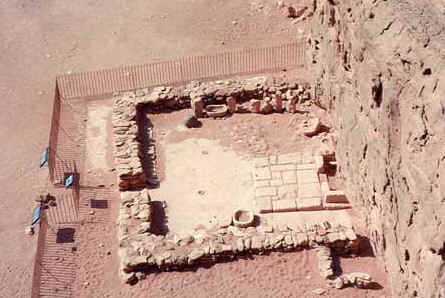Introduction
Nazareth
Capernaum
Tell Dan
pistachio
Caesarea
Philippi
Old Jerusalem
palm market
Lachish
Tell Beersheva
market
ibex
Timnah Park
Eilat
Hazor
|

March 1999
This is the Timnah Mining Park 25 kms. north of the Red Sea port city Eilat. The walls are
of a reconstructed temple used during the
Ramesside dynasties of Egypt until the time of Ramesses V (1148 - 1144 BC). Later it was used by the
"Midianites" who left some cultic copper snake figure in the temple,
reminiscent of the snake in the story of Moses. Archaeologists dug through sand littered with pottery shards to find the place.
The Egyptians and others were in the area to mine copper from the cliffs and ravines past the lone acacia tree near the horizon.
The Egyptian influence in this area and the nearby Sinai further disintegrated as Ramesses
VI was the last pharaoh to have a mining expedition mark their presence
in a south Sinai copper mining district.

Feb 2002
At Timnah I found a
ledge of sandstone with small nodules of green copper ore in the matrix.
After thousands of years of prospecting there is yet copper in the
ground.
There was a group of people living in Nahal Timnah after the Egyptians
abandoned their efforts called the "Midianites" by archaeologists.
They occupied the temple shown at the top of the page after the
Egyptians were gone. Their pottery was also found in Egyptian
occupied mining camps at Timnah from the 14th to 12th centuries BC (B.
Rothenburg, Were these King Solomon's Mines?, c. 1972). This type pottery was found at Timnah, the
Aravah, the north end of the Red Sea, Quraiya where it was kiln fired,
and elsewhere in
Northern Arabia. There was a thick strata containing this type of
pottery and its usage seemed to be popular for several centuries.
Later publication indicated the Quraiyah ware was found from the 13th to
9th century.
In the story of Moses, Moses escaped from slavery and
went to live in Midian (northern Arabia). There was some evidence
the story of Exodus was a literary work and not historical. God
did not murder the first born Egyptian babies during the Passover.
The book of Exodus was a myth handed down by Moses who never parted the
Red Sea, but wrote historical fiction. God was not a genocidal god
as depicted in the account of the Passover. The
book of Joshua was refuted by archaeological investigations. See
Old
Jericho.
Links to a map showing the distribution of Midianite
pottery.
http://www.bibleorigins.net/MidianiteAlQurayyaWaresMap.html
|